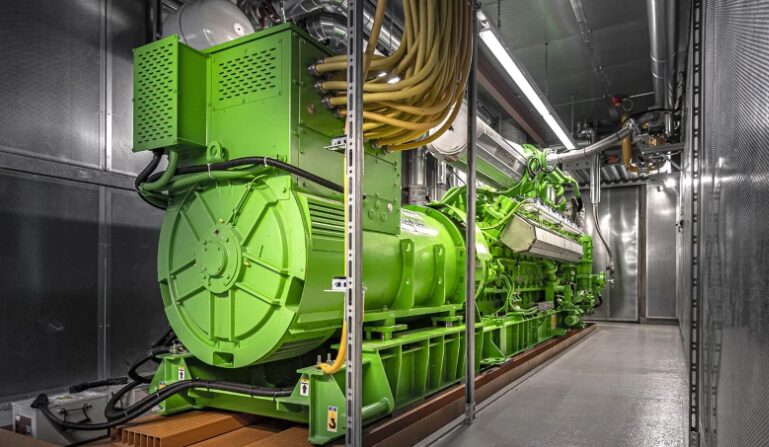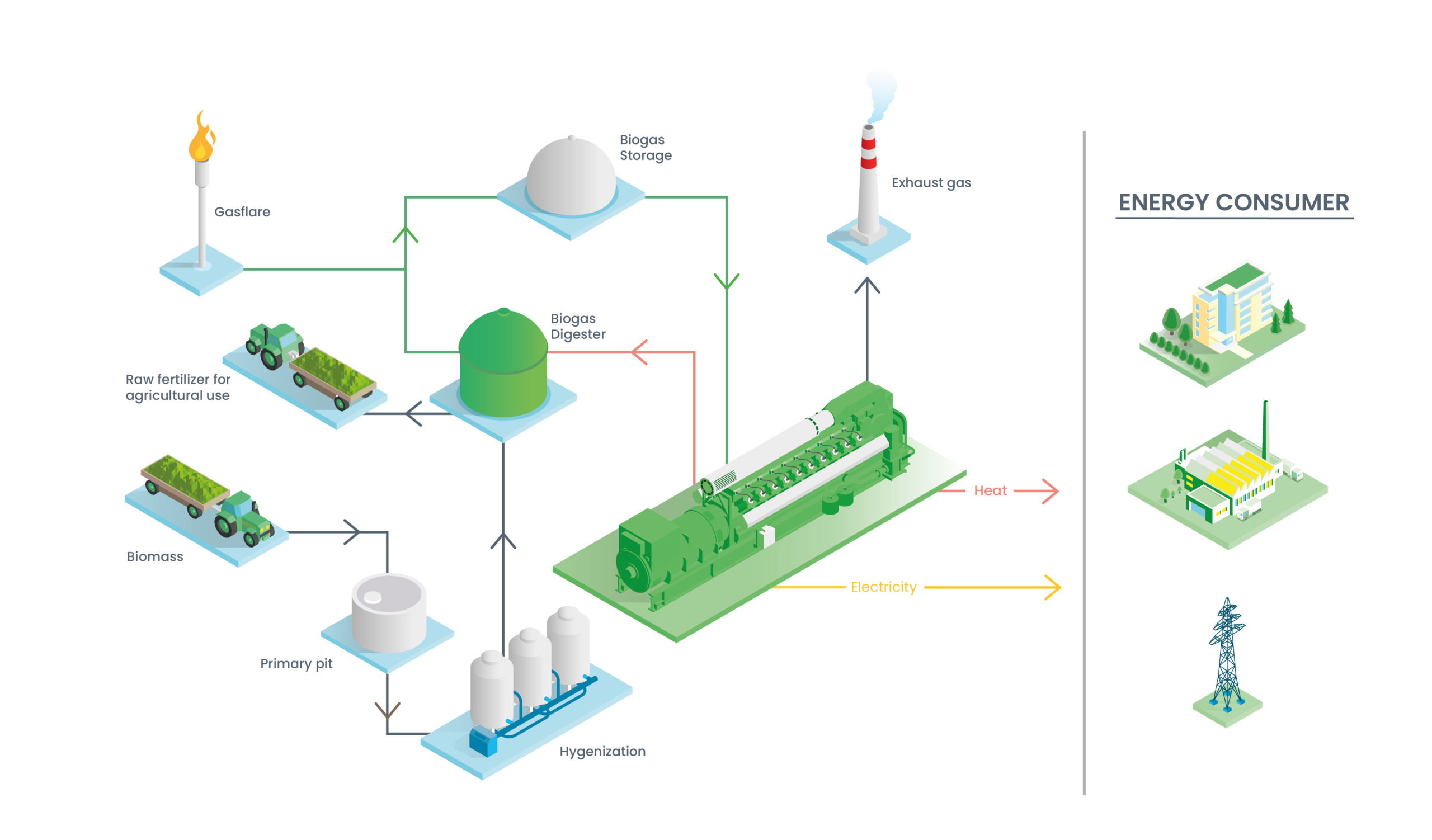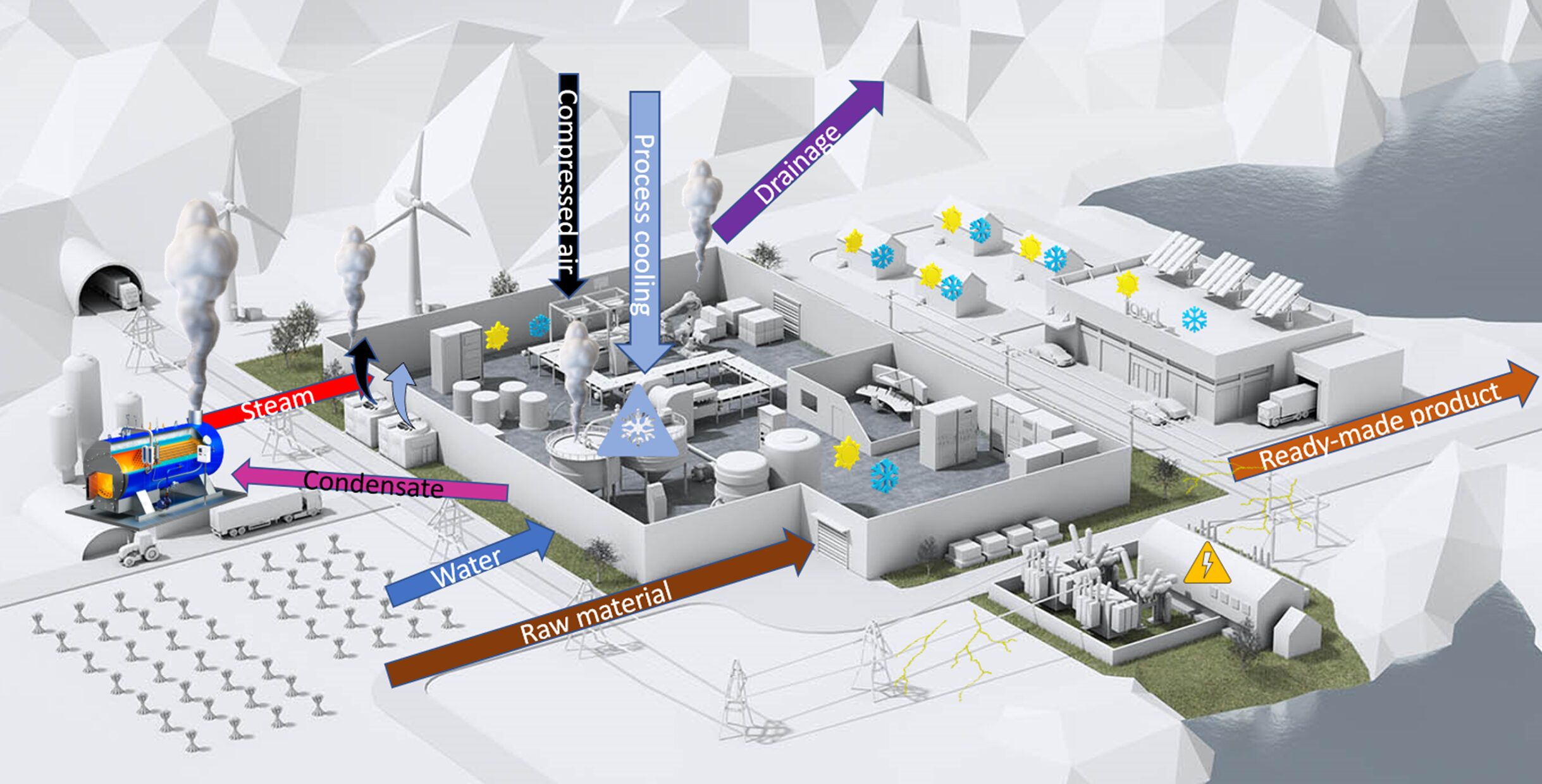Ajastul, mil jätkusuutlikkus ja kuluefektiivsus on äärmiselt olulised, otsivad tööstused üle maailma uuenduslikke viise oma energiakasutuse optimeerimiseks. Energiatõhusus ei ole lihtsalt moesõna, vaid oluline komponent ettevõtete jaoks, kelle eesmärk on vähendada tegevuskulusid, parandada tootlikkust ja täita rangeid keskkonnaeeskirju. Tutvustame kolme peamist tööstuslikku energiatõhusat lahendust, mis on sektorit revolutsiooniliselt muutmas.
Üleminek keskkonnahoidlikumatele energialahendustele
Tänapäeva tööstusmaastikul on energiatõhusus muutunud üheks peamiseks fookuseks. Ettevõtted otsivad pidevalt võimalusi kulude vähendamiseks, tegevuse tõhususe parandamiseks ja keskkonnamõju vähendamiseks. Üleminek keskkonnahoidlikumatele energialahendustele ei ole enam lihtsalt trend – see on vajadus. Kaasaegsed tehnoloogiad, nagu soojuse ja elektri koostootmisjaamad (CHP), biogaasisüsteemid ja soojuse taaskasutamise mehhanismid, on muutuste eestvedajateks. Need energiatõhusad lahendused pakuvad olulist kasu, alates kulude kokkuhoiust kuni parema jätkusuutlikkuseni.
Energiatõhususe tähtsus tööstuses
Energiatõhusus tööstuskeskkondades on oluline mitmel põhjusel. Esiteks on tööstussektor üks suurimaid energiatarbijaid kogu maailmas, mistõttu on see üks peamisi kasvuhoonegaaside tekitajatest. Energiatõhusate lahenduste kasutuselevõtmisega saab tööstus mängida olulist rolli kliimamuutuste vastu võitlemisel. Teiseks moodustavad energiakulud olulise osa tegevuskuludest. Energiasäästulahenduste rakendamine võib viia kulude märkimisväärse vähenemiseni, parandades seeläbi ettevõtte üldist kasumlikkust. Lõpuks sunnib regulatiivne surve ning tarbijate ja sidusrühmade kasvav nõudlus säästvate tavade järele tööstusharusid keskkonnahoidlikumaid energialahendusi kasutama. Selliste lahenduste kasutuselevõtt ei taga mitte ainult nõuetele vastavust, vaid parandab ka ettevõtte kui vastutustundliku äri mainet.
Case studies: tõhusate energiasüsteemide edukas rakendamine
Energiatõhusate lahenduste illustreerimiseks vaatleme mõningaid reaalseid näiteid, kuidas tööstusharud on edukalt üle läinud keskkonnahoidlikumatele energialahendustele ja saanud sellest kasu. Neid edulugusid uurides saame ülevaate täiustatud tehnoloogiate praktilistest rakendustest ja mõistame nende olulist positiivset mõju tegevuse tõhususele, kulude kokkuhoiule ja keskkonnasäästlikkusele.
Loe energialahendustest lähemalt
1. CHP ehk koostootmisjaamad – tööstuse energiatõhususe tulevik
Alustame sellest, mis on koostootmisjaam. Soojuse ja elektri koostootmisjaamad (CHP) on kaasaegsete energiatõhusate lahenduste nurgakivi. Need süsteemid toodavad elektrit ja koguvad soojust, mis muidu läheks raisku, kasutades seda kütteks. Tulemuseks on energiatõhususe märkimisväärne suurenemine ja kasvuhoonegaaside heitkoguste vähenemine. Maksimeerides ühest kütuseallikast saadava energia kasutamist, saavutavad koostootmisjaamad kuni 80%-lise tõhususe, mis teeb neist olulise tehnoloogia tööstusharude jaoks, mille eesmärk on parandada jätkusuutlikkust ja vähendada tegevuskulusid.

Koostootmisjaamade eelised säästva ja jätkusuutliku energia saamiseks
Koostootmisjaamad pakuvad säästva energiatootmise jaoks mitmeid eeliseid. Kuna koostootmisjaamad toodavad samaaegselt nii elektrit kui ka kasulikku soojust, võivad nad saavutada kuni 80%-lise kasuteguri, võrreldes tavapärase elektritootmise keskmise 50%-lise kasuteguriga. Selline kõrge kasutegur tähendab väiksemat kütusekulu ja väiksemaid heitkoguseid, mistõttu koostootmine on ideaalne lahendus tööstusharudele, kes soovivad täiustada oma lahendusi rohelise energia ja jätkusuutlikkuse valdkonnas.
Üks peamisi koostootmisjaamade tõhususe eeliseid on nende võime pakkuda detsentraliseeritud energiatootmist. See tähendab, et energiat toodetakse selle tarbimiskoha lähedal, mis vähendab ülekandekadusid ja parandab energiajulgeolekut. Lisaks sellele võivad koostootmisjaamad töötada erinevatel kütustel, sealhulgas maagaasil, biogaasil ja biomassil, tagades energiavarustuse paindlikkuse ja vastupidavuse.
Koostootmisjaama rajamise kulud ja kasutustulud
Koostootmisjaama maksumus sõltub selle suurusest ja konfiguratsioonist, kuid pikaajaline kokkuhoid võib olla märkimisväärne. Tegevuslik kasu hõlmab väiksemaid energiakulusid, paremat energiavarustuse kindlust ja suuremat vastupanuvõimet energiahinna kõikumistele. Lisaks sellele võivad koostootmisjaamad tagada usaldusväärse energiavarustuse, vähendades tööstustegevuse seisakute riski, nii et koostootmisjaama maksumus on seda väärt.
Koostootmisjaamu kasutanud tööstusharud on teatanud märkimisväärsest kokkuhoiust oma energiaarvete osas. Näiteks üks tootmisettevõte, mis paigaldas gaasimootoriga koostootmisjaama, täheldas energiakulude vähenemist 30% esimese tegevusaasta jooksul. Lisaks sellele paranes ettevõtte tegevuse tõhusus ja vähenesid kasvuhoonegaaside heitkogused, mis näitab koostootmise tehnoloogia ulatuslikke eeliseid.
2. Biogaas – taastuv ja säästev energiatootmine
Biogaas on teine oluline tegija taastuvenergia ja säästva energiatootmise maailmas. Biogaasist saadav energia, mida toodetakse orgaanilistest jäätmetest, on mitmekülgne energiaallikas, mida saab kasutada elektri, soojuse ja isegi sõidukite kütuse tootmiseks.

Elektrienergia tootmine biogaasijaamade abil
Biogaasi elektrijaamad muudavad orgaanilised jäätmed anaeroobse kääritamise protsessi abil biogaasist elektrienergiaks. Seejärel saab toodetud biogaasi kasutada elektri tootmiseks kas biogaasigeneraatorite või koostootmisjaamade kaudu. See ei paku mitte ainult taastuvat energiaallikat, vaid aitab ka jäätmete tõhusat käitlemist.
Anaeroobne lagundamine hõlmab orgaanilise aine lagundamist mikroorganismide poolt hapniku puudumisel. Protsessi käigus tekib biogaas, mis koosneb peamiselt metaanist ja süsinikdioksiidist. Metaani saab kasutada kütusena elektri ja soojuse tootmiseks, samas kui allesjäänud kõdu saab kasutada toitainerikka väetisena, sulgedes nii jäätmekäitluse ja energiatootmise ringi.
Biogaasilahenduste rakendamine
Biogaasi kütuseelemendiga elektrijaamade rakendamine tööstuslikes tingimustes hõlmab mitut etappi. Esialgu nõuab see orgaaniliste jäätmematerjalide kättesaadavuse hindamist ja süsteemi väljatöötamist, mis suudaks need jäätmed tõhusalt biogaasiks muuta. Ettevõtted saavad osta biogaasi elektrijaamu või teha koostööd tarnijatega kohandatud lahenduste väljatöötamiseks. Eelised hõlmavad väiksemaid jäätmekäitluskulusid, väiksemaid kasvuhoonegaaside heitkoguseid ja taastuvenergia tootmist.
Näiteks võttis suur põllumajandusettevõte kasutusele biogaasisüsteemi loomasõnniku ja põllukultuuride jääkide töötlemiseks. Biogaasi elektrigeneraator mitte ainult ei tootnud elektrit farmi toiteks, vaid andis ka soojust erinevate protsesside jaoks. See tõi kaasa märkimisväärse kulude kokkuhoiu, parema jäätmekäitluse ja farmi süsiniku jalajälje vähenemise.
Loe lisa energialahenduste kohta
3. Soojustagastus – suurem energiatõhusus
Soojustagastussüsteemid on tööstusprotsesside energiatõhususe suurendamiseks üliolulised. Need süsteemid koguvad ja taaskasutavad heitsoojust, mis muidu kaoks, parandades seeläbi üldist energiatõhusust ja vähendades tegevuskulusid. Heitsoojuse taaskasutamise ja kasulikuks energiaks muutmisega saavad tööstused oluliselt vähendada oma energiatarbimist ja kasvuhoonegaaside heitkoguseid. See mitte ainult ei aita säästa loodusvarasid, vaid aitab kaasa ka säästvamale ja kuluefektiivsemale tegevusraamistikule.

Soojustagastusega aurugeneraatorid: tehase jõudluse suurendamine
Soojustagastusega aurugeneraatoreid (HRSG) kasutatakse tavaliselt elektrijaamades ja tööstusrajatistes energiatõhususe parandamiseks. Need süsteemid koguvad heitsoojust gaasiturbiinidest või tööstusprotsessidest ja kasutavad seda auru tootmiseks, mida saab seejärel kasutada elektritootmiseks või kütteks. HRSG-d suurendavad märkimisväärselt tehase jõudlust ja aitavad säästa energiat.
Soojustagastusega aurugeneraatorid on eriti tõhusad kombineeritud tsükliga elektrijaamades, kus nad koguvad gaasiturbiinide heitsoojust täiendava elektri tootmiseks. See protsess võib tõsta elektrijaama üldise kasuteguri üle 60%, võrreldes lihtsa tsükliga gaasiturbiinijaamade 30-40% efektiivsusega. Suurenenud tõhusus vähendab kütusekulu ja kasvuhoonegaaside heitkoguseid.
Heitsoojuse taaskasutamine: liigse soojuse muutmine väärtuseks
Heitsoojuse taaskasutamine hõlmab tööstuslike protsesside liigse soojuse kinnipüüdmist ja selle muundamist kasulikuks energiaks. Heitsoojuse taaskasutamise tehnikad hõlmavad soojusvahetite, suitsugaaside ökonomaiserite, aurukatelde, soojuspumpade ja HRSG-de kasutamist. Heitsoojuse taaskasutamise abil saavad tööstused vähendada oma energiatarbimist, vähendada süsiniku jalajälge ja parandada üldist tõhusust.
Keemiatootmisettevõte rakendas heitsoojuse taaskasutamise süsteemi, et koguda soojust heitgaasidest. Tagastatud soojust kasutati auru tootmiseks, mis käivitas tehases mitmesuguseid protsesse. See mitte ainult ei vähendanud jaama energiatarbimist, vaid alandas ka selle tegevuskulusid ja kasvuhoonegaaside heitkoguseid, mis näitab heitsoojuse taaskasutamise märkimisväärset kasu.
Loe lisa energia taaskasutamise lahenduste kohta
FILTER Powering Industry – loome säästvaid energialahendusi tööstustele
FILTER aitab tööstustel üle minna säästvamatele ja energiatõhusamatele tavadele. Läbi uuenduslike tehnoloogiate ja terviklike energialahenduste toetab FILTER tööstusi nende nutika energiatarbimise eesmärkide saavutamisel. FILTER pakub terviklikke lahendusi – teostatavusuuringutest projekteerimise, ehitamise ja hoolduseni –, mis tagavad optimaalse jõudluse ja tõhususe. Ettevõtte lähenemisviis algab kliendi energiavajaduse põhjaliku hindamisega, mille tulemuseks on kohandatud koostootmislahendused, mis tagavad maksimaalse efektiivsuse ja kulude kokkuhoiu ning mida toetab pidev tugi ja hooldus.
FILTER on loonud mitmeid biogaasilahendusi, võimaldades tööstustel toota elektrit orgaanilistest jäätmetest, tõhustades seeläbi energiasäästlikke lahendusi ja jäätmekäitlust. Need skaleeritavad lahendused hõlmavad teostatavusuuringuid, projektide rahastamist ja abi eeskirjade järgimisel, luues pinnase sujuvaks integreerimiseks tööstustegevusega. Lisaks eristub FILTER täiustatud soojustagastussüsteemide osas, aidates tööstustel heitsoojust taaskasutada ja kasutada üldiste keskkonnasõbralikumate energialahenduste parandamiseks. Need lahendused, nagu soojustagastusega aurugeneraatorid, soojustagastusega aurukatlad ja soojusvahetid, koguvad tööstusprotsesside heitsoojust ja muudavad selle kasutatavaks energiaks, vähendades oluliselt energiatarbimist, tegevuskulusid ja keskkonnamõju. Energiasäästu võimalusega on ka märkimisväärne võimalus säästa vett ning enamus tööstuslikke soojuspumbalahendusi aitavad muuta avatud veekontuurid suletud ahelateks (nagu jahutussüsteemide puhul), vähendades nii magevee tarbimist kui ka heitvee vooluhulka.
FILTER oma laia energialahenduste valikuga, on nr 1 partner, et toetada tööstuskliente nende teekonnal tõhususe ja jätkusuutlikkuse poole. Lisateabe saamiseks tööstuse energiatõhususe parandamise kohta rohelise energia lahendustega võtke meiega ühendust.. Nutikalt loodud tulevik. Suurem meelerahu.



